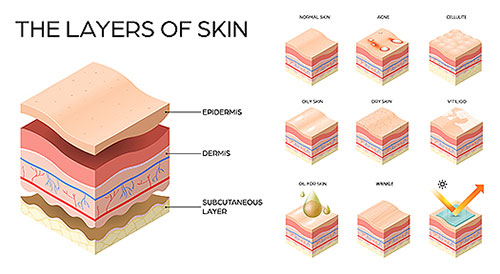Functions of Skin and Skin Care
The skin, the largest organ of the body with its appendages hair and nail, is embryologically derived from the neuroectoderm, the same unit that forms the nervous system in the human body. Hence, a number of skin problems have some associated neurological/psychological issues & vice versa.

Structurally, the skin consists of 3 layers – the epidermis, the dermis and the subcutaneous tissue.
The epidermal cells are referred to as keratinocytes. The keratinocytes have receptors for a number of hormones and other molecules. The superficial layers of the epidermis or the outer layers of the epidermis maintain the barrier function of skin. Vitamin D synthesis is also an important function of this unit of the skin. Specialized receptors for touch, pressure, etc. are located here.
The skin colour is determined by a cell type called melanocytes located predominantly in the basal layer of the epidermis. The pigment produced is melanin, the type & quantity of which decides the skin colour of a person. Melanin production varies in different populations on exposure to sun and 6 skin types (type 1 to type 6) are recognized bases of burn & tan response.
The dermis & subcutaneous tissues provide the structural (collagen & elastic fibers with ground substance) & neuro vascular framework for the integrity of the skin.
The skin also has its glandular components namely the sweat glands (eccrine and apocrine) & sebaceous glands. The eccrine sweat glands play an important role in the regulation of body temperature through the production and elimination of sweat through the sweat duct and sweat pores.
The sebaceous glands located in certain areas of the body are now recognized as a unique neuroendocrine unit with receptors for hormones and other mediators. They produce an oily secretion sebum, which acts as a natural moisturizer in certain areas like scalp, face, etc.
The skin also has its own resident microflora which prevents colonization by pathogenic micro-organisms.
The main functions of the skin are:
- Protection of the interior of the body from external insults like allergens, irritants & infection causing pathogens.
- Regulation & maintenance of body temperature by the sweat glands in response to changes in environmental temperature.
- The skin also has specialized receptors for touch, pain, pressure, etc. which help to carry stimuli from the external environment to the various neural pathways for eliciting appropriate responses.
- Synthesis of vitamin D.
Care for the Skin
- A well-balanced diet with adequate water intake goes a long way in the maintenance of good skin health.
- Bathing/washing of the skin surfaces with water and gentle preferably non-fragrant, soap or syndet.
- Too much lathering to be avoided as it may cause excessive dryness leading to the development of eczema.
- Use of bath brushes, loofah and coir for scrubbing to be avoided as they can cause a difficult to treat skin condition called cutaneous amyloidosis.
- Face/scalp cleansing as per the nature of the skin (dry, oily and sensitive) & presence of disorders.
- Cleansing of skin with undiluted antiseptics to be avoided as they cause irritation.
- Soaps containing antiseptics are to be avoided for general use as they can destroy the natural skin flora & facilitate the growth of pathogens. They are to be used only for cleansing after coming in contact with contaminated surfaces or for preparing areas prior to procedures.
- Oiling of the hair shafts can be done for conditioning and ease of combing, but overenthusiastic scalp oil application and vigorous oil massage of the scalp to be avoided especially in persons with dandruff/seborrheic dermatitis.
- Specialized hair treatments and facial procedures done in salons to be approached with caution, especially in persons with sensitive skin.
- Care should be taken to ensure that the nail cuticles are not removed during manicure/pedicure procedures.
- Shaving of hair anywhere to be done along the line of the hair follicle alignment & not across to prevent development of folliculitis.
- Persons with dry skin disorders/sensitive skin to keep their skin well moisturized with a simple preferably non-fragrant moisturizer.
- Persons with acne should not pop out or scratch out pimples. They should seek a dermatologist’s help.
- Persons with dark patches on the neck, underarms, etc., should not scrub vigorously thinking that it is some accumulated dirt. It could be acanthosis nigricans which would need medical advice to rule out diabetes or hypothyroidism or PCOS.
It is impossible to change one’s natural colour. Nobody should be attempting that. We can maintain a good healthy skin in whatever colour we are born with. Self-medication with depigmenting creams prescribed for hyper-pigmentary disorders should be avoided as it can lead to long-term skin damage, which can become difficult to reverse.
Avoid self-medication with over-the-counter creams for skin problems. Consult a dermatologist if there is a persistent skin problem.
Skin Donation
Skin banks are now coming up where one can pledge their skin to be used after their demise to help burns patients. Strips of skin are taken from some areas of the body without causing any disfigurement and are stored in an appropriate fashion in skin banks. They are then used to graft areas of burnt skin.

Dr Vijay Kartik V
Consultant Dermatologist
Kauvery Hospital, Chennai

